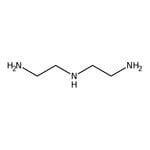Search Thermo Fisher Scientific
Bis-(2-aminoethyl)-amin, 99 %, Thermo Scientific Chemicals



Bis-(2-aminoethyl)-amin, 99 %, Thermo Scientific Chemicals
Chemikalien-Kennzeichnungen
Spezifikationen
Beschreibung
This Thermo Scientific Chemicals brand product was originally part of the Alfa Aesar product portfolio. Some documentation and label information may refer to the legacy brand. The original Alfa Aesar product / item code or SKU reference has not changed as a part of the brand transition to Thermo Scientific Chemicals.
Diethylenetriamin wird als Lösungsmittel für Kunststoffe, Farbstoffe und in der chemischen Synthese verwendet. Es dient als Härtemittel für Epoxidharze. Als Tridentatligand bildet es Komplexe wie Co(dien)(NO2)3 in der Koordinationschemie. Es wird auch als Kraftstoffzusatz verwendet. Es reagiert mit Fettsäure, was zur Bildung von Amidoaminen führt, die in der Mineralölindustrie als Korrosionshemmer eingesetzt werden. Es ist mit unsymmetrischem Dimethylhydrazin zur Vorbereitung von Hydyne verbunden, einem Treibmittel für Flüssigbrennstoffraketen.
Löslichkeit
Mischbar mit Wasser und Ethanol. Nicht mischbar mit Ether.
Hinweise
Luftempfindlich. Kühl lagern. Behälter an einem trockenen und gut belüfteten Ort dicht verschlossen halten. Nicht kompatibel mit starken Oxidationsmitteln, starken Säuren und Kupfer.
Abbildungen
Dokumente und Downloads
Zertifikate
Häufig gestellte Fragen (FAQ)
Zitierungen und Referenzen
Sicherheit und Handhabung
Classification of the substance or mixture
CLP classification - Regulation(EC) No 1272/2008
Label Elements
Signal Word
Danger
Hazard Statements
H302 + H312 - Harmful if swallowed or in contact with skin
H314 - Causes severe skin burns and eye damage
H317 - May cause an allergic skin reaction
H330 - Fatal if inhaled
H335 - May cause respiratory irritation
Precautionary Statements
P260 - Do not breathe dust/fume/gas/mist/vapors/spray
P280 - Wear protective gloves/protective clothing/eye protection/face protection
P303 + P361 + P353 - IF ON SKIN (or hair): Take off immediately all contaminated clothing. Rinse skin with water or shower
P304 + P340 - IF INHALED: Remove person to fresh air and keep comfortable for breathing
P305 + P351 + P338 - IF IN EYES: Rinse cautiously with water for several minutes. Remove contact lenses, if present and easy to do. Continue rinsing
P310 - Immediately call a POISON CENTER or doctor/physician